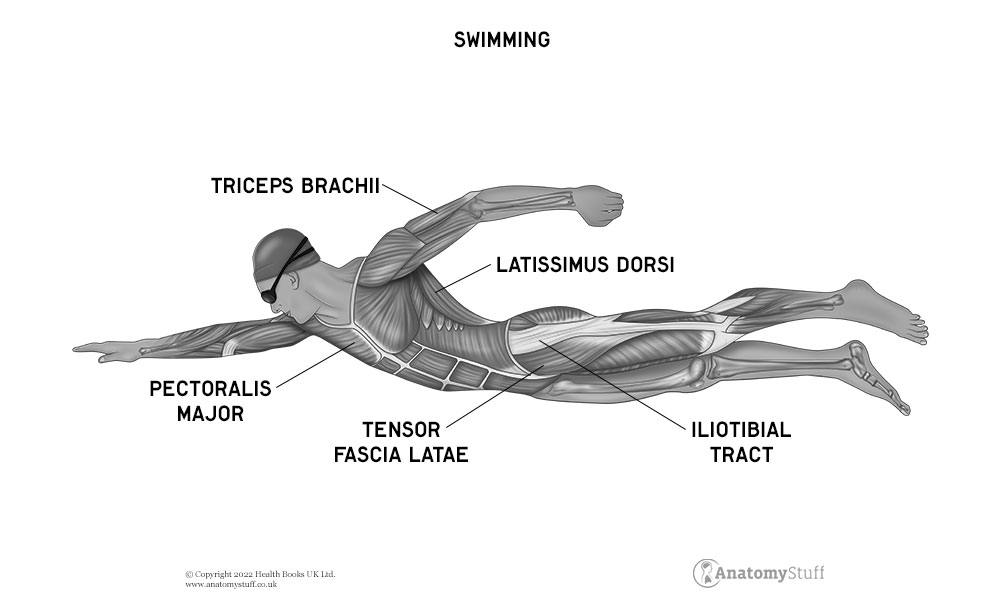Swimming Anatomy
Did you know swimming is one of the healthiest aerobic exercises you can do? Studies report that even 30 minutes of a swimming routine will benefit your body from head to toe.
Unlike other aerobic or cardio exercises, swimming doesn’t require much, only a will to swim in the water. Note that you shouldn’t wait for summer to beat the heat. Instead, swimming should be part of your daily routine, especially if cycling or running hurt your back or high-impact exercises are a big no for you.
Swimming benefits our bodies in several ways. And in some ways, swimming even surpasses the benefits of cardio workouts. That’s right!
How Swimming Benefits Our Body
One of the best things about swimming is that there is no significant age requirement. Any person at any age can start learning to swim. Experts claim that a 60 min swimming routine would do just fine for younger children.
Let’s now learn about swimming anatomy and its benefits in a bit more detail.
Muscle tone:
As you swim through the water, the muscles of the arms, legs, abdomen, back, and glutes act against water resistance. This intensifies the muscle tone and improves the overall strength of the body.
Reduces stress & anxiety:
Swimming minimises the release of hormones that cause stress and increases the number of endorphins that are responsible for eliciting a good mood. These changes in hormonal levels relieve stress and ward off anxiety and depression while uplifting your mood.
Cardiovascular benefits:
Swimming is known to increase heart rate healthily. As athletes would claim, swimming is a great addition to your cardio routine. Studies suggest that individuals who swim regularly have a lower mortality risk than those who live a sedentary lifestyle, assuming all other health issues are adjusted.
Moreover, swimming lowers the bad cholesterol (LDL) and increases the good cholesterol (HDL) levels in the body. Hence, it is also a healthy option for people with hypertension.
Reduces weight:
Swimming is an excellent option for those who want to stay fit. Regular swimming may help you maintain weight and burn calories.
Reports suggest that swimming regularly also helps control blood glucose levels. Therefore, people with diabetes or obesity are encouraged to swim or participate in pool exercises.
Minimise insomnia:
Swimming has also proven effective in providing better quality sleep. The hormonal changes help improve mindfulness delivering a calming effect to the brain.
Positive effect on joints:
Due to the buoyancy of the water, swimming is easy on stress-bearing joints. The water supports your muscles and joints, reducing the stress put on them. This ultimately reduces joint pain and stiffness. Therefore, swimming is also good for people with arthritis and pregnant women.
Provides healthy lungs:
If you have health issues with your lungs, know that some chemicals used in the pool may worsen your breathing problems. However, swimming itself is a great exercise in providing better control over breathing, and it makes the lungs more efficient by increasing lung capacity. This, in turn, keeps your lungs healthy and improves cardiovascular functioning.
Free PDF Downloads
View AllGood for injured people or people living with a disability:
People who have an injury are encouraged to swim as they can’t do high-impact exercises. Of course, pending medical approval after the injury.
Moreover, other cardio exercises like cycling or running can strain your back; swimming is rather harmless in that matter.
The swimming water provides gentle resistance and support to the body; hence, it is also good for people with neuronal or physical injuries.
Summary
Swimming is a healthy exercise, especially for those who can’t afford a high-impact or vigorous activity.
It sure does have a few drawbacks; for example, swimming regularly may result in dry and scaly skin or rashes. The chemicals used in pools can also damage hair and eyes. However, from bones to deep organs, swimming strengthens the whole body.
All in all, swimming must not only be considered a summer sport but considering its multiple benefits, it is wise to incorporate swimming into your workout routine.
Related products
View All














